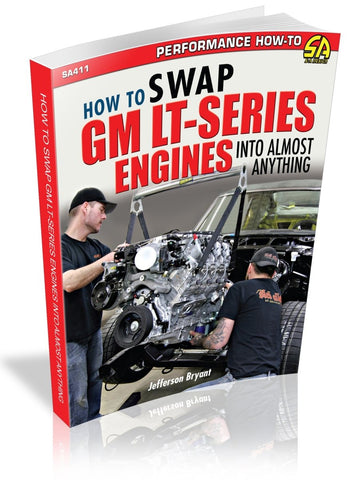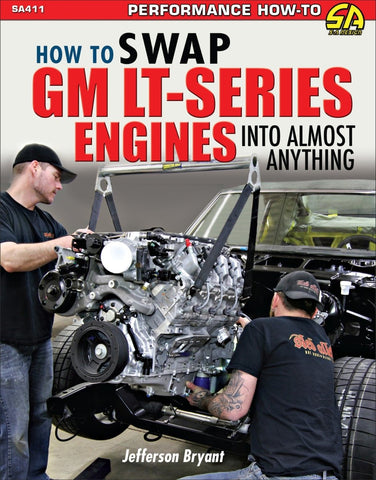Discover the latest GM swap technology in this all-new, comprehensive LT swapper’s guide.
The GM LS engine has dominated the crate and engine-swap market for the past 20 years, and now the new LT engine has become a popular crate engine for swap projects as well. As essentially the next-generation LS, the LT features a compact footprint, lightweight design, and traditional V-8 pushrod architecture similar to its predecessor, so it swaps easily into many classic cars, hot rods, and even foreign sports cars.
The new LT1/LT4 takes a bold step forward in technology, using active fuel management, direct injection, an upgraded ignition system, continuous variable valve timing, and a wet- or dry-sump oiling system. With this advanced technology and higher performance, more engine swappers are using the LT platform. Swapping expert and longtime author Jefferson Bryant presents thorough instruction for each crucial step in the LT swap process.
Although the new LT shares the same basic engine design with the LS, almost all of the LT engine parts have been revised and updated. As a result, the mounting process has changed substantially, including motor-mount location, K-member mounting process, and component clearance; all these aspects of the swap are comprehensively covered. The high-compression direct-injected engines require higher-pressure fuel systems, so the fuel pump and fuel lines must be compatible with the system. LTs also feature revised bellhousing bolt patterns, so they require different adapter plates. The oil pan profile and oiling systems are unique, and this can present crossmember clearance problems. All other important aspects of the swap process are covered, including accessory drives and cooling systems, engine management systems, tuning software, controllers, and exhaust, so you can install the LT in popular GM A- and F-Body platforms as well as almost any other chassis. Solutions for the major swapping challenges, parts compatibility, and clearance issues are provided.
Muscle car, hot rod, truck, and sports car owners have embraced the new LT platform and the aftermarket has followed suit with a wide range of products to facilitate swap projects. This book affords comprehensive guidance so you can complete a swap with confidence. If you have a project in the works, are planning a project in the near future, or if you simply want to learn how the swap process takes place, this book is for you.
Acknowledgments
Introduction
Chapter 1: What Is the Gen V LT-Series Engine?
LT Car Engines
Gen V Truck Engines
Engine-Swap Projects
Swapping Problems
Chapter 2: Engine and Transmission Mounts
Motor Mounts
Adapter Plates
GM Truck Mounts
Transmission Mounts
Chapter 3: Oil Pans
Factory Oil Pans
Aftermarket Oil Pans
Oil System Modifications
Chapter 4: Accessory Drives and Cooling Systems
Stock Drives
AC Compressor Retrofit
Aftermarket Drives
Aftermarket Accessory Drive Assembly
Cooling Systems
Gauge Sensors
Chapter 5: Transmissions
Automatic
Manual
Chapter 6: Wiring
Factory Harness
Aftermarket Harnesses
Sensors
Chapter 7: ECMs and Controllers
ECMs
Sensors
Throttle Pedal
Tuning
DOD Delete
Transmission Controllers
Chapter 8: Fuel System
Fuel Pumps
Fuel Control Module Pressure Sensor
Return Lines
Chapter 9: Exhaust Systems
Exhaust Manifolds
Aftermarket Headers
Catalytic Converters
Air Intake
Source Guide
Discover the latest GM swap technology in this all-new, comprehensive LT swapper’s guide.
The GM LS engine has dominated the crate and engine-swap market for the past 20 years, and now the new LT engine has become a popular crate engine for swap projects as well. As essentially the next-generation LS, the LT features a compact footprint, lightweight design, and traditional V-8 pushrod architecture similar to its predecessor, so it swaps easily into many classic cars, hot rods, and even foreign sports cars.
The new LT1/LT4 takes a bold step forward in technology, using active fuel management, direct injection, an upgraded ignition system, continuous variable valve timing, and a wet- or dry-sump oiling system. With this advanced technology and higher performance, more engine swappers are using the LT platform. Swapping expert and longtime author Jefferson Bryant presents thorough instruction for each crucial step in the LT swap process.
Although the new LT shares the same basic engine design with the LS, almost all of the LT engine parts have been revised and updated. As a result, the mounting process has changed substantially, including motor-mount location, K-member mounting process, and component clearance; all these aspects of the swap are comprehensively covered. The high-compression direct-injected engines require higher-pressure fuel systems, so the fuel pump and fuel lines must be compatible with the system. LTs also feature revised bellhousing bolt patterns, so they require different adapter plates. The oil pan profile and oiling systems are unique, and this can present crossmember clearance problems. All other important aspects of the swap process are covered, including accessory drives and cooling systems, engine management systems, tuning software, controllers, and exhaust, so you can install the LT in popular GM A- and F-Body platforms as well as almost any other chassis. Solutions for the major swapping challenges, parts compatibility, and clearance issues are provided.
Muscle car, hot rod, truck, and sports car owners have embraced the new LT platform and the aftermarket has followed suit with a wide range of products to facilitate swap projects. This book affords comprehensive guidance so you can complete a swap with confidence. If you have a project in the works, are planning a project in the near future, or if you simply want to learn how the swap process takes place, this book is for you.
Acknowledgments
Introduction
Chapter 1: What Is the Gen V LT-Series Engine?
LT Car Engines
Gen V Truck Engines
Engine-Swap Projects
Swapping Problems
Chapter 2: Engine and Transmission Mounts
Motor Mounts
Adapter Plates
GM Truck Mounts
Transmission Mounts
Chapter 3: Oil Pans
Factory Oil Pans
Aftermarket Oil Pans
Oil System Modifications
Chapter 4: Accessory Drives and Cooling Systems
Stock Drives
AC Compressor Retrofit
Aftermarket Drives
Aftermarket Accessory Drive Assembly
Cooling Systems
Gauge Sensors
Chapter 5: Transmissions
Automatic
Manual
Chapter 6: Wiring
Factory Harness
Aftermarket Harnesses
Sensors
Chapter 7: ECMs and Controllers
ECMs
Sensors
Throttle Pedal
Tuning
DOD Delete
Transmission Controllers
Chapter 8: Fuel System
Fuel Pumps
Fuel Control Module Pressure Sensor
Return Lines
Chapter 9: Exhaust Systems
Exhaust Manifolds
Aftermarket Headers
Catalytic Converters
Air Intake
Source Guide










